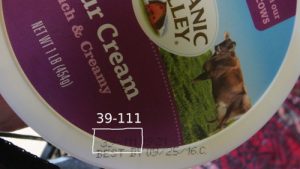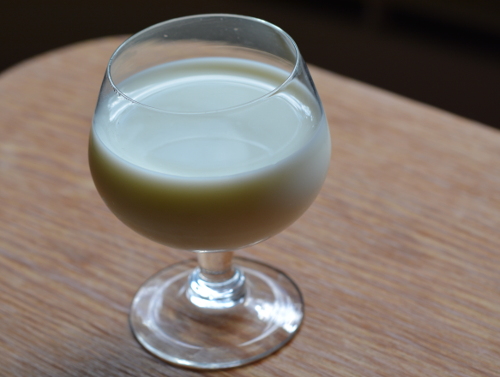(To read the older posts in this blog, click here.)
I do love my daily cup of whole milk with a dash of espresso. The Husband is a coffee aficionado and crafts the espresso at home on his manual La Pavoni. The bean, the roast, the grind, the pressure, the speed at which the lever comes down, creaking… it’s a fine art! Then I commit the blasphemy of drowning the oils and flavors in a large cup of milk. Oh well, such are the vagaries of marriage.
But, about the milk. To give you an idea of how I am going about sourcing local/regional food and deciding which is a good one to try, I thought I’d show you how I analyzed the situation for dairy.
Before yesterday, our go-to milk was Organic Valley (OV). I remember a few years ago someone asked me why I buy OV, which is more expensive than the organic Whole Foods milk, for instance. “It’s all the same milk,” he said. My response was that OV is a coop, and I support that kind of economy. I still do, but now that I am also interested in local sources, a quick visit to Where is My Milk From is enough to disabuse anyone from the impression that OV milk is “regional” in any sense of the word. Ohio, Indiana, Washington… The same goes for Stonyfield (not a coop) yogurt, which makes sense because they get their dairy from Organic Valley.
 At Where is My Milk From you enter the code on the carton or container, and it instantly tells you which dairy your milk, yogurt, chocolate milk, soy or organic milk, coffee creamer, cottage cheese, ice cream, etc. came from. You should try it, it’s a geography lesson for sure. This OV sour cream, for instance, is from Orville, Ohio: the cows who made this milk are therefore a 651 mile drive from the fridge in which it now lives, and who knows how many more miles it traveled on its route to arrive?
At Where is My Milk From you enter the code on the carton or container, and it instantly tells you which dairy your milk, yogurt, chocolate milk, soy or organic milk, coffee creamer, cottage cheese, ice cream, etc. came from. You should try it, it’s a geography lesson for sure. This OV sour cream, for instance, is from Orville, Ohio: the cows who made this milk are therefore a 651 mile drive from the fridge in which it now lives, and who knows how many more miles it traveled on its route to arrive?
Time to look for alternatives.
At the local grocery store. So let’s say I want to keep the convenience of buying my local milk when shopping or other groceries. At my local Whole Foods I took note of:
- Butterworks Farm – Westfield, Vermont – organic
- Crescent Ridge – “fresh, local, Sharon, MA”
- Sky Top in New York
- High Lawn Farm – “Made in the Barkshires,” more precisely in Lee, MA
I looked up all these guys with several questions in mind:
- Is the milk “grown” on the farm? (It just doesn’t seem right to say milk is “produced”: a cow is not a factory.) Or are they a distributor for several farms, and if so, where is the milk from then?
- Where does the cow feed come from? That too is part of the loop!
- Are they a coop, or family-owned, etc.?
- What are their practices: organic, knowledgeable and conscientious, etc.
Some of the information on the bottles can be misleading. Crescent Ridge, for instance, looked very promising: “fresh, local, Sharon, MA.” Sharon is 30 miles away – score, right? However, Sharon is where the milk they get is pasteurized and homogenized, not grown. They partner with St. Albans Cooperative Creamery in St.Albans, Vermont and Appleton Farms in Ipswich, MA. If it comes from the latter, great: that’s only 44 miles away. St.Albans, however, is 250 miles from here, and they’re a distributor themselves, so where do they get the milk? “With a membership base of over 360 farms, the [St. Albans] CO-OP markets more than 3 million pounds of milk a day to a variety of customers throughout the Northeast” (source). I don’t think I want to type source codes into Where is My Milk From at the grocery store to find the one from Ipswich. If I get this milk home delivered, I won’t have any choice.
Butterworks Farm was promising too: they are just the one farm so the milk is from Westfield, VT, they are certified organic, and they grow all the grain for their cows, chickens, etc. themselves. But they are still 230 miles away.
Sky Top Farms in New York is a pretty small, five farm operation, and kudos to Whole Foods for giving them space on their shelves. Their milk is, however, not homogenized and unfortunately the kid won’t drink it. Also, they’re pretty far away: Norwich, New York, one of their farms (it’s not easy to find where the other farms are located) is 270 miles away.
At the grocery store, High Lawn Farm wins: one family-owned farm, all milk from cows grazing in Lee, MA, 113 miles away. They “grow most of the feed for our cows at the farm: Corn, alfalfa and grass are the main crops supporting the health and nutrition of our Jerseys. Our herd enjoys the pastures from late spring through late fall, or as long as the grass is growing here in the Berkshires… We plant corn, alfalfa and grass annually as an essential part of their feed.” They go even further: “We use 100% of our cow manure as a fertilizer for our corn and forage crops, and when needed supplement manure fertilization with commercial fertilizers to perfectly balance the needs of the soil for healthy crop production” (source). Now these are people who understand sustainability and the closing of loops! They’re not organic, but I like their approach.
Go to the source myself? Let’s say I want to change the way I shop and go to the creamery myself. Then there is this nifty milk finder on Mass.Gov. Now, not owning an electric vehicle, I’d not like to drive too far for this milk. The closest one is in Dracut, MA, at 30 miles, or Lunenburg, at 33 miles. There is also the Lawton’s Family Farm, whence the yummy fromage blanc, which sells raw milk (at the farm only) and they’re 22 miles away. Too far for a weekly drive…
What about the local food coops? The Mass Local Food Coop only carries goat milk.
The local health food store? Debra’s Gourmet in Concord stocks the same High Lawn milk my local Whole Foods sells.
The Farmers Market! There is occasional opportunity here. Our small but abundant Wayland Farmers Market is graced off and on by the Contoocook Creamery in Contoocook, New Hampshire (83 miles). They only seem to sell their cheeses at the market, but I could call them and ask them to bring milk. They weren’t at the market this week, though. A pity, because I do like them. From their website here and here: “We grow three hundred acres of grass and about one hundred fifty acres of corn. Remember that the corn plant is a grass, and we use the whole stalk, not just the kernel… Both of these are harvested as silage. That means that the whole plant is chopped into little pieces, about ½ an inch long and then fermented to preserve it. We pack the feed into long concrete silos to store it. This makes up about 50% of what the milk cows eat. We send samples of our grass and corn silage to a laboratory in Maryland to have it analyzed for protein, energy, and mineral content. It is then Tom our nutritionist’s job to balance the feed with purchased grains and minerals to meet the cows needs. Most of the grains we buy are left over products of our food manufacturing industry…”
In the end, High Lawn Whole Milk, bought at Whole Foods, won out, and it’s yummy. I also brought their heavy cream ($4.19 for 1 pint) and their lightly salted butter (1 lb. tub for $6.99). For yogurt, we plan to make our own. Maybe we’ll even try to make our own ice cream. Local cheeses there are plenty, and I hope to get round to going a blog post on them, but until then, this is a nice resource.
I think this is one of the food stuffs I won’t change after the diet is over. If you have a closer source of high-quality, easily accessible, locally grown milk, cheese, cream, ice cream, etc. please let us know it the comments.
They are facing disastrous conditions and need our help. One of the roles we, early adopters, can play is to support these local dairies with our $$. It is undeniable that their products are more expensive than the much cheaper mass-produced and mass-distributed brands. But if we want regional and affordable dairy by 2060, we want these dairy farmers to grow their business and herds. We want more of them. We want more land in pasture and corn fields. We are willing to be “early investors,” to keep them growing, to keep them going. Because they’re in trouble. I wanted to share this alert I received a few days ago from the New England Farmers Union
——
Take Action to Protect Family Dairy Farmers in New England!
Below is an urgent action alert from our friends at the New England Farmers Union regarding our region’s family dairy farms. We hope that you will consider making a quick phone call to your Senators and Representatives today and share this alert in your network.
Family dairy farms form the backbone of New England’s agricultural economy, landscape and rural character. And right now, many of these farms are in trouble. They are facing the perfect storm of:
Low prices – 37% below the 2014 price;
Revenue from milk sales well below cost of production;
Regionally higher cost of production;
Unprecedented drought conditions causing significant reductions in feed and forage yields; and
A Dairy Margin Protection Program (MPP) that isn’t working for New England’s family dairy farms.
Maine dairy farmer and New England Farmers Union (NEFU) board member Mary Castonguay and I will be in Washington, DC this week for the National Farmers Union (NFU) 2016 Fall Legislative Fly-In. We will be urging our Congressional delegation to take bold action on behalf of our imperiled dairy farmers. The timing of this fly-in could not be better. We only have a narrow window of opportunity to raise awareness and ask Congress to provide immediate disaster assistance relief to support this critical sector of New England agriculture.
Right now, during our fly-in, is an essential time for you to call your representatives in Congress to let them know that New England Dairy Farmers need our help, and they need it now!
You can find contact information for your Representatives in the House here and your Senators here.
Please call your representatives in Congress today and and give them this simple message: “I care about family dairy farms in New England. Please support disaster assistance relief for them today.”
Thank you for your support of New England dairy farmers.
Sincerely,
Roger Noonan
President, New England Farmers Union
